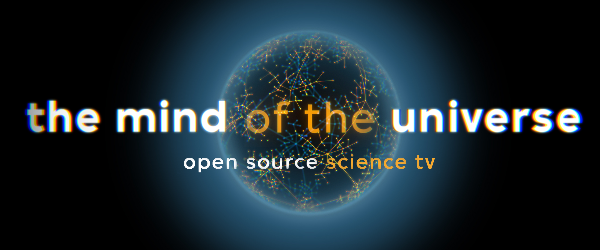Last year, the Dutch public broadcaster VPRO produced a ten-part documentary series titled The Mind of the Universe, in which leading scientists from various fields were interviewed about their work. Aware of their role as a public institution, and looking for bigger impact, VPRO decided to distribute this series under an open license, allowing other people to re-use the materials for educational purposes. To cater to the needs of these ‘secondary’ users, VPRO, in collaboration with The Netherlands Institute for Sound and Vision, launched a platform “Open Source Science TV”. On the platform the materials can be searched and downloaded, allowing anyone to create their own new productions with the material.
We have the pleasure of talking a bit more about the project with Jesse de Vos, Researcher Interactive Media at The Netherlands Institute for Sound and Vision. Jesse was closely involved with the project and wrote down the experiences of the project in the paper: “Publication of Public Broadcasting Content in the Commons”.
– Could you tell us about your role in the project?
JV: After the publication of the materials on the platform “Open Source Science TV”, I uploaded the videos to Wikimedia Commons, the media database of Wikipedia. We tried to encourage the reuse of those videos in articles on Wikipedia, which proved to be quite a challenge for various reasons. After the project was finished I interviewed various participants and wrote a practitioner’s statement, reflecting on our experiences in publishing this content under an open license.
– As mentioned in the paper, in 2010, Peter B. Kaufman published the white paper “Video for Wikipedia and the Open Web”, about the open publication of video. Almost a decade later, however, publishing openly is still far from common practise. Could you tell us why it is still so difficult to openly publish newly produced content?
JV: The obvious reason is, of course, that there are far fewer possibilities for generating income once the materials can be watched, edited and redistributed for free. Apart from that there can be legal restrictions. In the Netherlands for instance, public broadcasters can only publish materials under open licenses under very specific conditions. Finally, I think there is still a lack of awareness of the possibilities of open publication and the impact it has on the various stages of production. Hopefully our project and paper can make a contribution there.
– Why is it important that cultural en educational institutions make a shift toward more open publications?
JV: Cultural and educational institution serve a public cause. To me, if this role is taken seriously, open publication seems like a logical choice. These institutions have limited resources to generate maximum impact. Through open publication they can increase their impact drastically. It offers opportunities for engagement with communities that have similar interests and similar goals. It opens up new platforms for distribution. It facilitates new partnerships between organisations, etc. Don’t get me wrong, I’m not saying everything produced should be published under open licenses. But especially where educational purposes are served, open publication should be considered.
– You mentioned the platform “Open Source Science TV” that was launched as a part of the project. What will we find on the platform?
JV: Another challenge with open publication is how to facilitate users who are not familiar with the production. Therefore, this platform contains not only all the raw materials of the interviews but we also manually segmented and tagged the material, and generated a transcript through automated speech recognition which allows people to search the interviews full text. Information about the license is easy to find and the materials can be downloaded in various file formats and qualities. By publishing materials in such a way reuse has been made much easier.
– What is the role of/ and what differences can the Wikimedia Community make?
JV: Wikimedia is definitely one of the important communities that serve a public cause in the open distribution of information and knowledge. It’s the fourth most visited website worldwide, and to think that it is completely maintained by a community of volunteers always amazes me. Seeing openly published materials used in Wikipedia articles that get millions of views each month is hard to beat in terms of reach with our own platforms. Besides that, a Wikipedia article provides valuable context to any video-content shown in it. Not all video material is equally suited for use in an online encyclopedia. But where possible institutions should consider making their content available to the Wikipedia community.
– What have been some of the results of open publication for The Mind of the Universe?
JV: On Wikipedia, 34 articles in six language versions contain video material from The Mind of the Universe. These articles are being read approximately 75.000 times per month. We were hoping for more, but we have also learned more through the project about the type of content that works best on the online encyclopedia. In addition, VPRO has worked with various universities to create online learning experiences, reaching an audience of thousands, potentially millions. It is always important to note that these are the results so far. Over time we will probably see more uses of the material and greater reach.
Read more about the experiences of the project in the practitioners’ statement. In it the various stages of publication are described and how these are affected by the notion of open publication. The statement concludes with: publishing broadcasting materials under an open license comes with a number of challenges, but where these are tackled, there are significant benefits.



